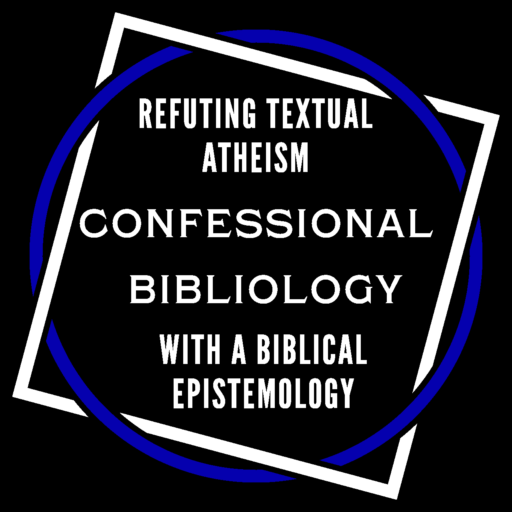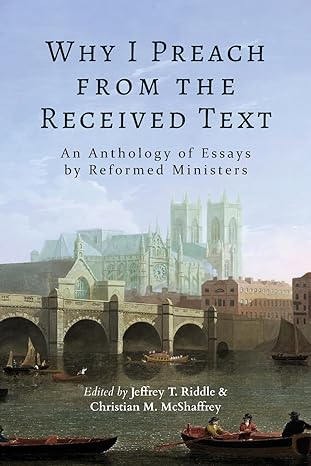1. Bibliographic Information
Title: Why I Preach from the Received Text: An Anthology of Essays by Reformed Ministers
Editors: Jeffrey T. Riddle & Christian M. McShaffrey
Publisher (Year): The Greater Heritage (2022)
Length: Twenty-five essays (plus editorial introduction and ancillary sections), spanning roughly 300+ pages (hardcover/paperback/eBook formats), supplemented by an annotated bibliography and practical appendices. Exact page count varies by format, but the work stands as a substantial anthology.
2. Overview / Introduction
Main Purpose/Thesis
Why I Preach from the Received Text: An Anthology of Essays by Reformed Ministers collates 25 essays from pastors, elders, teachers, and church leaders, all of whom explain their convictions about the text of Scripture they use in study and preaching. Each author argues in favor of retaining the traditional (or “Received”) Greek text of the New Testament (commonly referred to as the Textus Receptus, or TR) and the corresponding Hebrew Masoretic text in the Old Testament. The anthology maintains that the “modern critical text”—the apparatus behind most 20th- and 21st-century English translations—does not align with a Reformed confessional stance on divine preservation. By emphasizing the historical-theological heritage, the book purports that confessional Reformed Christianity should adhere to the text used by the Reformers and Puritans from which the major Reformed confessions (e.g., Westminster, Belgic, London Baptist) were derived.
Context
Across contemporary evangelical and Reformed circles, debates over textual criticism abound. On the one hand, supporters of modern critical editions (e.g., Nestle-Aland, UBS Greek texts) contend that newly discovered manuscripts, especially from Egypt, correct a “corrupted medieval tradition.” On the other hand, those aligning with the Received Text emphasize the historic confessional claims about providential preservation, a consistent text used by the church, and the dangers of placing textual authority in an ever-fluctuating academic discipline. Each essay in this anthology is effectively a personal account—some historical, some exegetical, some pastoral—detailing why a minister has concluded that the TR (and its corresponding translations, notably the Authorized/King James Version in English) should be the default textual basis for preaching and teaching.
Editors’ Background
- Jeffrey T. Riddle: Pastor of Christ Reformed Baptist Church (Louisa, Virginia), known for his blog and podcast (Textualconfidencecollective, etc.) and for engaging in public dialogues/ debates on textual issues.
- Christian M. McShaffrey: Minister in a confessional Presbyterian context (Orthodox Presbyterian Church), co-editor with Riddle, similarly committed to confessional bibliology.
Their editorial introduction establishes that they sought pastors serving “in the trenches” of local church ministry. The book, therefore, is less of an academic monograph on textual criticism and more of a “pastoral stance,” though theological and historical arguments are certainly present. Each contributor wrote his essay independently; the editors assembled these into a cohesive volume under the banner “Why I Preach from the Received Text.”
3. Chapter-by-Chapter (or Thematic) Summary
Rather than offering a laborious 25-chapter synopsis in an identical structure, it may be more helpful to group the essays thematically while noting some individual highlights. The anthology does, however, list them from 1 to 25, introduced by an editorial piece, and concludes with an appendix and annotated bibliography.
Editorial Introduction (Jeffrey T. Riddle & Christian M. McShaffrey)
The editors present the impetus for this collection: they observe that an increasing number of Reformed and Presbyterian pastors—both older and younger—are questioning whether the reliance on a modern critical text is consistent with classic Protestantism. They note that modern textual criticism (with its Westcott-Hort genealogical approach, subsequent eclecticism, and reliance on newly discovered papyri) stands in tension with the confessional statements that “God, by his singular care and providence, kept [Scripture] pure in all ages” (WCF 1.8). In an era of skepticism, they propose that the single question “Do we have God’s Word entirely, or do we have to keep reconstructing it?” looms large. The introduction thus primes the reader to see how 25 authors personally resolve that question.
1. “Infallible Truth, Not Probability” (Archibald Allison)
Allison’s essay underscores an existential question for preachers: Is the text we hold in our hands the certain Word of God or an ever-shifting approximation? He insists that God’s Word never fails, never requires “probabilistic” guesswork. He cites examples in modern Greek editions that carry a “grade of certainty” rating for each variant, showing how uncertain one can be if leaning on the critical text. Instead, he sees the TR as emanating from a doctrine of providential preservation where the church never lost the true text.
2. “Is There Such a Thing as an Authentic Text?” (Jonathan Arnold)
Arnold asks a question at the heart of textual criticism: “What is the autographic text, and can we truly identify it?” By examining the Reformed Confessions, he ties in WCF 1.8 to highlight that the “Old Testament in Hebrew” and “New Testament in Greek” were kept pure, not hidden away. He critiques the idea that older manuscripts discovered in the 19th century necessarily trump the consistent text used in the mainstream church tradition.
3. “God’s Word as Creation—A Reason I Preach from the TR” (Doug Barger)
Barger employs a theological metaphor: God’s spoken Word as a unique creation, superintended across the centuries. He draws on confessional statements about God’s “special providence in preserving Scripture.” For Barger, the TR is not just an accident of history; it is the recognized deposit of Scripture given to the church for centuries. He insists that a modern text that omits or brackets large passages undermines the notion of a stable, “once for all delivered” deposit.
4. “From Atheism to the Authorized Version” (Gavin Beers)
A personal testimony from Beers: he narrates a youthful atheism, then his conversion, culminating in recognition of the KJV as the English translation of the traditional text. He acknowledges that textual differences were not, at first, front and center in his conversion, but upon deeper theological study, he found comfort in the Reformed confessional stance that God’s Word remains accessible entire to his people. He finishes by emphasizing that new textual theories too often inject doubt rather than certainty.
5. “The Text of the Church” (Poul de Gier)
De Gier focuses on the history of how the church recognized and transmitted Scripture, highlighting that textual variation was never so radical as to necessitate continuous reconstruction. He addresses some frequent arguments for the modern text (e.g., “older is better”) and contends that a critical text that severs itself from the consistent usage of the majority church tradition is suspect. He points to confessional statements that treat the text as settled, not in flux.
6. “Promise and Faith” (Tanner Dikin)
Dikin underscores a pastoral dimension: how can pastors instill faith in the Word if the Word itself is riddled with disclaimers in footnotes about missing verses or uncertain readings? He draws on personal ministry anecdotes where church members stumbled at “footnotes that question entire passages.” The TR approach, in his view, fosters a stable preaching environment. He also notes that the Puritans rarely agonized over textual variants because they believed in a stable, ecclesiastically received text.
7. “John Owen’s Defense of the Received Text” (William O. Einwechter)
One of the more historical essays. Einwechter expounds the legacy of John Owen’s treatise Of the Integrity and Purity of the Hebrew and Greek Text of Scripture. Owen was responding to Roman Catholic polemicists who argued that the Greek text was corrupt, thus justifying the Vulgate. Owen insisted that the extant Greek text, recognized by Protestant churches, was indeed the providentially preserved original. Einwechter thereby situates the debate historically: we are not dealing with a new phenomenon but continuing a 17th-century battle for the sure foundation of Scripture.
8. “Preaching in the Name of the Amen” (Brent C. Evans)
Evans interweaves a homiletical approach: referencing Revelation 3:14, the “Amen” of Christ. He highlights how frequently the word “Amen” is omitted or bracketed in modern translations (e.g., ends of New Testament epistles). Evans contends these small omissions have theological import, given the confessional emphasis on every jot and tittle. He thus invites the preacher to consider that the text is not a mere neutral document but an inspired deposit, replete with theological significance in every detail.
9. “Should We Use Those Proof Texts?” (Philip Gardiner)
Gardiner addresses “proof texting” in confessional documents. Many passages used in the Westminster Catechisms are precisely those texts modern critics question (e.g., 1 John 5:7, the doxology of the Lord’s Prayer). He wonders if Reformed believers can consistently hold the confessions—where these texts are heavily used for doctrinal demonstration—and yet adopt a text that omits them. Gardiner’s reflection resonates with historically minded readers who see the confessional exposition of major doctrines as buttressed by the readings of the traditional text.
10. “The Reformed Christian’s Text” (Dane Johannsson)
Johannsson condenses the fundamental argument: The Reformed confessional tradition—whether Presbyterian or Baptist—grew out of a consistent textual basis. If we hold to those same confessions, we should be consistent in adopting that same text. He underscores that one’s textual theory is not merely an academic preference but inherently connected to confessional theology, especially the statements about Scripture’s preservation.
(Essays 11–25 continue in similar vein, each with personal and theological reflections. For brevity, we will note just a few standouts.)
14. “Scripture Identified Scripture” (Robert McCurley)
McCurley’s essay is especially strong on canonical self-attestation: the Holy Spirit testifies to believers that the text is God’s Word. He references the phenomenon of the early church’s public reading: the church recognized and received the canonical books in the Greek text that was standard at that time. He challenges the notion that recently discovered papyri or local textual traditions can override centuries of reception.
15. “From Certainty, to Doubt, and Back Again” (Christian M. McShaffrey)
The co-editor’s personal journey: McShaffrey recalls that early in his seminary training, he embraced the critical text approach as a sign of “scholarly maturity,” but he found it introduced more doubts than clarity. Through further reading of confessional statements and Reformed orthodox writings, he regained his former certainty in the TR, concluding that the simpler “old paths” better align with the faith that Scripture is stable and sure.
20. “Train Up a Child” (Jeffrey T. Riddle)
Drawing from Proverbs 22:6, Riddle focuses on family catechesis. He mentions how footnotes in modern Bibles can confuse younger readers, who ask, “Why does my Bible bracket the last 12 verses of Mark or omit John 7:53–8:11?” Riddle advocates a stable text for instructing children. He also references historical catechisms that quote disputed verses as doctrinal pillars, e.g., 1 Timothy 3:16 in the Westminster Larger Catechism’s Christology.
Appendix: “Steps Toward Change in Your Church”
A short but practical resource: If a local church is convinced to transition from a modern version to the KJV (or a new translation of the TR), how might they do so pastorally, carefully, and transparently? The editors provide advice on introducing “Textus Receptus–based ministry” to a congregation possibly unaware of textual debates, avoiding abrupt mandates or condemnation, and patiently teaching the theological rationale.
A Select Annotated Bibliography
Multiple references for further reading, including the forebears of modern textual criticism, the Reformed orthodox like Owen, Turretin, and Whitaker, as well as contemporary works—some are short articles or tracts, while others are extended treatises from the Trinitarian Bible Society, Sovereign Grace Advent Testimony, or individual pastors.
4. Strengths
Strength 1: Emphasis on Practical Theology
Though textual criticism can be an arid discipline, this anthology emphasizes pastoral and devotional angles. Many essays recount real-life pastoral experiences (e.g., confusion among children in Sunday School, perplexity among new converts reading modern notes, or the spiritual crisis caused by a sense that Scripture is uncertain). This pastoral perspective is refreshing. It reminds readers that textual debates affect ordinary Christians in the pews.
Strength 2: Confessional-Historical Alignment
The anthology offers ample historical documentation. Writers frequently cite the Reformers (Luther, Calvin, Beza) and post-Reformation theologians (Turretin, Owen, Whitaker), demonstrating that the Reformed tradition historically affirmed a received text, not a text in constant need of “scientific reconstruction.” The volume’s synergy with Reformed confessions resonates with readers who prize confessional continuity.
Strength 3: Variety of Voices
The 25 contributors come from different denominational backgrounds (Reformed Baptist, Presbyterian, some with Dutch Reformed leanings), across multiple English-speaking countries (the U.S., Canada, Australia, the U.K.). The personal testimonies are also quite diverse. Some were raised from childhood in KJV-only style churches, others discovered the TR position later. This variety appeals to a broad Reformed audience: not a monolithic group, but a mosaic of pastors converging on the same textual stance.
Strength 4: Encouraging Tone toward Opponents
While the authors hold convictions strongly, in general the anthology’s tone is not acerbic or triumphalist. Most essays show empathy for well-intended evangelical scholars who hold a critical text perspective. For instance, several authors mention that many modern version advocates remain orthodox in gospel preaching. The anthology tries to avoid personal attack, though it does strongly critique the presuppositions of modern textual criticism. This cordial approach may win a more sympathetic hearing.
Strength 5: Inclusion of Appendices & Annotated Bibliography
The practical tips on transitioning a congregation from a modern version to the Received Text are unique. Often, textual discussions remain theoretical. Here, the final appendices help pastors chart a wise path, addressing potential misunderstandings or backlash. The annotated bibliography is also valuable, pointing readers to both older works (e.g., John Owen’s treatise) and more recent publications. For those wanting deeper dives, the editors supply clear directions for further reading.
5. Weaknesses
Weakness 1: Limited Direct Engagement with Counterarguments
Most essays function as personal or pastoral reflections rather than systematic refutations of modern textual criticism. While the anthology does contain historical theology, direct engagement with the specifics of critical text methodology (e.g., the canons of internal vs. external evidence, genealogical classification, etc.) is relatively light. Readers seeking a robust line-by-line critique of Westcott-Hort or NA28 might wish for more specialized analysis.
Weakness 2: Some Overlapping Content
An inevitable downside to a multi-author anthology is repetition. Essays rehash certain verses often (like the Mark 16:9-20 ending, the “Johannine Comma” of 1 John 5:7, or the doxology of the Lord’s Prayer). While each writer’s vantage is distinct, some readers might find the repetitive referencing of the same textual controversies tedious. The editorial team might have structured the volume to reduce overlap or combine arguments about the same verses.
Weakness 3: Uneven Scholarly Depth
As the contributors are primarily pastors, their essays vary in scholarly rigor. Some are well-researched, referencing manuscripts, original-language scholarship, or textual critics from the 16th–19th centuries. Others are simpler testimonies: “I personally found confusion in footnotes, so I returned to the TR.” The book is pitched more as a practical-lay/pastoral resource, so academically-minded readers may desire deeper exegesis or direct interaction with standard critical text publications (e.g., Metzger’s Textual Commentary, Aland’s Introduction to the NT). The relative brevity of some essays may disappoint those seeking an advanced treatise.
Weakness 4: Potential Perception of Insularity
While the essays do not typically disparage non-TR Christians, some critics might see the anthology as “preaching to the choir.” The volume strongly commends the TR and only tangentially addresses how to have ecumenical or collegial relationships with evangelicals who prefer ESV, NASB, or NIV. The repeated assertion, “God has always used the TR,” may ring simplistic to some who note that the Greek Orthodox tradition or certain early Alexandrian lines complicate the claim. The anthology might not fully answer concerns about the complexity of textual transmission in the earliest centuries.
Weakness 5: Minimal Discussion of Old Testament Textual Issues
“Received Text” discussions typically focus on the Greek New Testament. While the volume’s premise includes a commitment to the Masoretic Text for the Old Testament, few essays delve deeply into the OT side. The vantage is predominantly NT-based—chapters revolve around Mark 16, John 7:53-8:11, 1 John 5:7, etc. Old Testament textual criticism, the role of the Septuagint, and how Reformed orthodoxy historically treated OT variants, remain under-explored. This leaves a lacuna for readers curious about the “Received Masoretic Text.”
6. Conclusion / Final Assessment
Overall Impression
Why I Preach from the Received Text showcases how textual criticism is not an abstract academic enterprise but intersects with the spiritual vitality of local church ministry. The volume’s vantage is confessional: it regards the classic Protestant confessions and the church’s historical usage as integral to identifying the stable text of Scripture. From “Infallible Truth, Not Probability” to “Why Advocate for the Received Text?” the authors champion the concept that we do possess a preserved text—one that fosters confidence in the pulpit and pew. The anthology’s “multiple testimonies” approach provides a variety of angles, from theological rationales to personal journeys, from historical insights to pastoral counsel.
Key Takeaways
- Confessional Preservation: The central thesis is that the Reformed tradition has always taught providential preservation, meaning that the text recognized at the Reformation (the TR) is the stable standard, not a temporary placeholder pending future manuscript discoveries.
- Pastoral Certainty: Many contributors worry that pastors relying on an eclectic text that changes with each new critical edition cannot speak with the same dogmatic assurance. A major impetus behind retaining the TR is the rhetorical and spiritual power of preaching a stable text.
- Historic Continuity: The authors frequently highlight the usage of the TR by the Reformers, Puritans, and subsequent Reformed orthodoxy. The modern critical text, in their view, is an 19th/20th-century phenomenon not deeply rooted in confessional orthodoxy.
- Ecclesiastical Reception: Emphasizing that Scripture was entrusted to the church, they argue that the church’s universal usage of a consistent textual family stands in tension with novel theories that prefer minority manuscripts from an allegedly “earlier” Alexandrian tradition.
Recommended For
- Pastors & Elders in Confessional Reformed Traditions: This volume speaks directly to those who have begun questioning how to handle textual variants in sermon preparation. It also equips them to teach their congregations a confessional approach to Scripture’s preservation.
- Seminarians or Bible College Students: The essays challenge a typical “critical text default” taught in many institutions. Students can glean a biblical-historical rationale for adopting or re-embracing the TR viewpoint.
- Lay Readers in Reformed Contexts: Because of its predominantly pastoral style, laymen can follow the arguments. They will discover that the question “Which Greek text underlies my Bible?” is not trivial or inconsequential.
- General Textual Critics: Even those who remain unconvinced by the anthology’s conclusions may appreciate the inside perspective. While the book is unapologetically confessional, it clarifies reasons for the TR stance that are often misunderstood in the broader text-critical community.
Rating (Optional)
On a five-star scale for a confessional/pastoral resource, it merits 4.5/5. The mixture of testimonies and theology is edifying and intellectually engaging, though an in-depth refutation of modern text-critical theories might still be sought elsewhere. For laymen wanting a user-friendly introduction to the Reformed Received Text perspective, it is an excellent resource. Scholars might crave more details on variant genealogies or patristic citations, but the anthology’s stated aim is pastoral rather than purely scholarly.
Final Word
Why I Preach from the Received Text: An Anthology of Essays by Reformed Ministers stands as a significant contribution to ongoing textual debates within Reformed circles. It reminds us that textual criticism is never merely academic, but profoundly shapes how pastors proclaim God’s Word and how congregations receive it. Far from being a niche concern, it addresses foundational issues of biblical authority, assurance, and the deep bond between Scripture and the church that has guarded it. With its multi-author mosaic of convictions, experiences, and theologies, the anthology urges a return to classical Reformed bibliology—asserting that the best path forward is to stand where the Reformers stood, trusting in a providentially preserved text that continues to nourish the church across generations.





